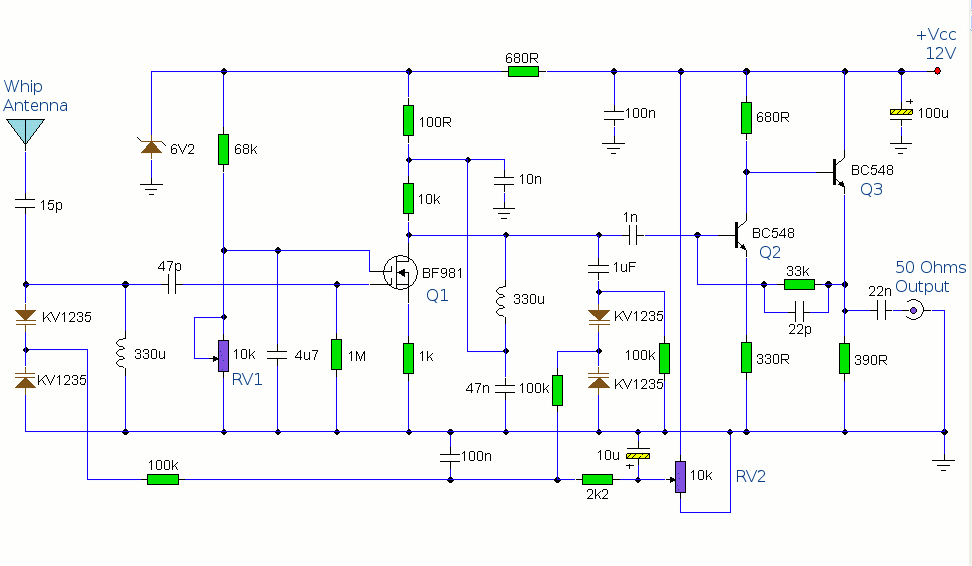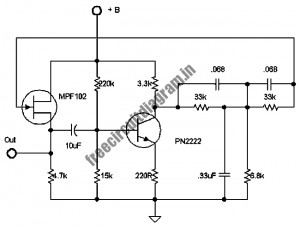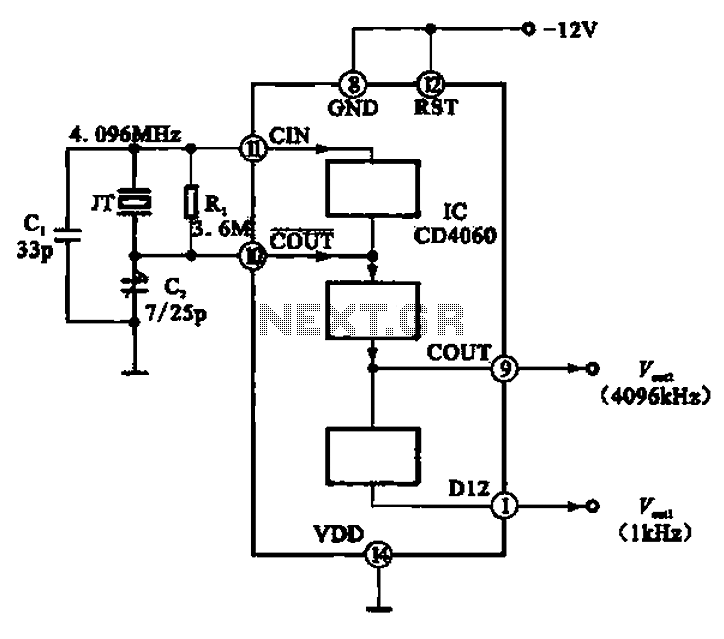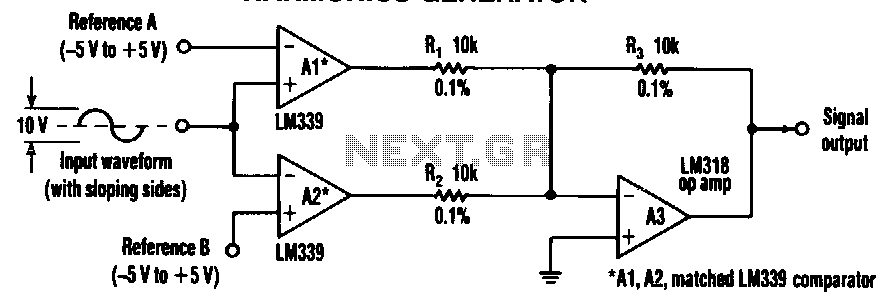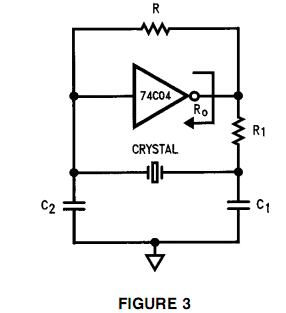
audio sine wave generator
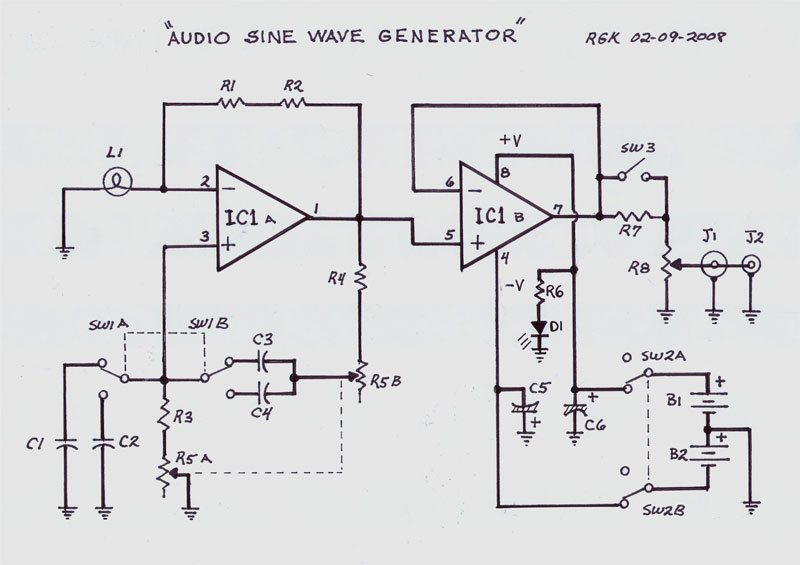
This single integrated circuit (IC) design is based on the Wien Bridge Oscillator, generating low distortion sine waves within a frequency range of 15 Hz to 22 kHz across two output voltage levels: approximately 0-250 mV and 0-2.5 Vrms. The accompanying image illustrates a 1 kHz output signal from the generator. The schematic features a TL082 dual operational amplifier functioning as both the oscillator and buffer amplifier. The output signals are sufficiently robust to drive eight-ohm headphones, with a standby current drain of about 6 mA from each battery. For user convenience, two output jacks are included. The circuit's gain is modulated by lamp L1 and resistors R1 and R2; increasing these resistor values reduces negative feedback, thereby enhancing oscillation until distortion occurs. Conversely, excessively lowering R1 and R2 values will halt oscillation. A general guideline suggests that the cold resistance of the lamp should be approximately one-third the combined resistance of R1 and R2. The lamp has a cold resistance of 105 ohms, with resistance values of 216 ohms permitting oscillation, while values of 416 ohms and above lead to signal clipping. A total resistance of 363 ohms was determined optimal (330 ohms + 33 ohms). During oscillation, the lamp heats up, increasing its resistance to stabilize the circuit's gain. The frequency is set by potentiometer R5 and associated capacitors. Feedback to the positive input through these RC networks induces oscillation at a specific frequency, which can be calculated using the formula f = 1 / (6.28 x R x C) for other frequency ranges. Resistors R3 and R4 limit the upper frequency range. For high output LEDs, a 4.7 kΩ resistor should be used for R6, while a 1 kΩ resistor is suitable for standard LEDs, which serve solely as on/off indicators. Although lamp L1 is not restricted to a specific type, using a different lamp necessitates adjustments to R1 and R2 values. Various lamps were tested during prototyping, with the #1764 lamp providing optimal performance. To begin construction, cut the printed circuit board material to dimensions of 5.5 inches wide by 3.75 inches deep. The provided pattern can be used to mark drill points with a punch, followed by drawing lines with a marker for etching. Components should be mounted and soldered accordingly. Two wooden pieces (preferably oak) should be cut to dimensions of 1 inch thick by 3 inches long and 2.5 inches high for the sides. A piece of 0.062-inch aluminum should be cut to 5.5 inches wide by 5 inches high for the front panel. Additionally, cut a piece of white mat cardboard to 4.5625 inches wide by 2.5 inches high for the dial plate. Two aluminum pieces should be bent to form battery holders and attached to the wooden sides prior to further assembly. Finally, the entire unit should be assembled and soldered.
The Wien Bridge Oscillator circuit is renowned for its ability to produce stable sine wave outputs with minimal distortion, making it suitable for a variety of audio applications. The use of a TL082 dual operational amplifier enhances the performance by providing low noise and high gain characteristics, which are essential for maintaining signal integrity across the frequency range. The circuit's design employs a feedback mechanism that adjusts gain dynamically, allowing for consistent oscillation without external intervention.
The choice of lamp L1 is critical; its resistance characteristics play a pivotal role in the stabilization of the circuit's gain. The interaction between the lamp and resistors R1 and R2 forms a feedback loop that is sensitive to changes in load and temperature, which is beneficial for maintaining oscillation under varying conditions. The use of resistors R3 and R4 is equally important, as they define the frequency response of the circuit, ensuring that the output remains within specified limits.
In terms of physical assembly, attention to detail during the construction phase is crucial for ensuring reliability and performance. The specified dimensions for the printed circuit board and the enclosure components will facilitate proper fit and function. The use of high-quality materials, such as oak for the sides and aluminum for the front panel, will enhance the durability of the final product.
Overall, this circuit design exemplifies a practical application of the Wien Bridge Oscillator, combining theoretical principles with hands-on construction techniques to produce a functional audio generator. The careful selection of components and adherence to design guidelines will result in a robust and effective sine wave generator suitable for various audio testing and experimentation scenarios.This single IC circuit which is based on the Wien Bridge Oscillator, produces low distortion sine waves in the range of 15 Hz up to 22KHz in two ranges. The two output voltage ranges are from about 0-250mV and 0-2. 5Vrms. The image to the right shows an actual 1KHz output signal from the generator. The schematic below shows a TL082 dual operational amplifier being used as an oscillator and buffer amp. Signals at the output are adequate enough to drive eight ohm phones. Standby current drain is about 6mA from each battery. Two output jacks are provided for convenience The gain of this circuit is controlled by lamp L1 and resistors R1, R2. As the values of these resistors is raised, there is less negative feedback and thus, the circuit oscillates better up to a point where it becomes distorted.
Lowering the values of R1 and R2 too much will cause the circuit to stop oscillating. The general rule is that you want the cold ohmic value of the lamp to be about 1/3 the value of the resistor combination R1, R2. This lamp measures 105 ohms cold and it was found that resistance values of 216 ohms just allowed the circuit to oscillate, while 416 ohms and up caused signal clipping.
Thus a total value of 363 ohms was settled upon (330 ohms + 33 ohms). During oscillation, the lamp heats up a bit and its value raises to stabilize the circuit`s gain. Meanwhile, frequency is determined by pot R5 and the associated capacitors. It is the feedback to the positive input through these RC networks that causes oscillation at a particular frequency. The formula f=1 over 6. 28 x R x C may be used to determine oscillating frequency, should you wish other ranges. R3 and R4 simply limit the high end of each frequency range. For high output LEDs, use a 4. 7K resistor for R6. For standard LEDs, use a 1K resistor. The LED serves as an on/off indicator only. Regarding lamp L1, it does not have to be this particular one, however if you use another you will have to adjust the values of R1 and R2.
Many lamps were tried in prototyping, with the #1764 giving the best all around performance. Begin by cutting out the printed circuit board material to 5 1/2 in. wide by 3 3/4 in. deep. I personally, simply use the pattern on the right to mark all of the drill points with a punch and then draw the lines with a Sharpie pen and then etch. Mount components and solder. Cut two pieces of wood ( I prefer Oak) to in. thick by 3 in long x 2 ½ in. high for the sides. Cut a piece of. 062 aluminum to 5 ½ in wide x 5 in. high for the front panel. Finally cut a piece of white mat cardboard to 4 9/16 in. wide x 2 ½ in high for the dial plate. Bend two pieces of aluminum to form battery holders and attach them to the wood sides before any further construction.
Now assemble the entire unit and solder. 🔗 External reference
The Wien Bridge Oscillator circuit is renowned for its ability to produce stable sine wave outputs with minimal distortion, making it suitable for a variety of audio applications. The use of a TL082 dual operational amplifier enhances the performance by providing low noise and high gain characteristics, which are essential for maintaining signal integrity across the frequency range. The circuit's design employs a feedback mechanism that adjusts gain dynamically, allowing for consistent oscillation without external intervention.
The choice of lamp L1 is critical; its resistance characteristics play a pivotal role in the stabilization of the circuit's gain. The interaction between the lamp and resistors R1 and R2 forms a feedback loop that is sensitive to changes in load and temperature, which is beneficial for maintaining oscillation under varying conditions. The use of resistors R3 and R4 is equally important, as they define the frequency response of the circuit, ensuring that the output remains within specified limits.
In terms of physical assembly, attention to detail during the construction phase is crucial for ensuring reliability and performance. The specified dimensions for the printed circuit board and the enclosure components will facilitate proper fit and function. The use of high-quality materials, such as oak for the sides and aluminum for the front panel, will enhance the durability of the final product.
Overall, this circuit design exemplifies a practical application of the Wien Bridge Oscillator, combining theoretical principles with hands-on construction techniques to produce a functional audio generator. The careful selection of components and adherence to design guidelines will result in a robust and effective sine wave generator suitable for various audio testing and experimentation scenarios.This single IC circuit which is based on the Wien Bridge Oscillator, produces low distortion sine waves in the range of 15 Hz up to 22KHz in two ranges. The two output voltage ranges are from about 0-250mV and 0-2. 5Vrms. The image to the right shows an actual 1KHz output signal from the generator. The schematic below shows a TL082 dual operational amplifier being used as an oscillator and buffer amp. Signals at the output are adequate enough to drive eight ohm phones. Standby current drain is about 6mA from each battery. Two output jacks are provided for convenience The gain of this circuit is controlled by lamp L1 and resistors R1, R2. As the values of these resistors is raised, there is less negative feedback and thus, the circuit oscillates better up to a point where it becomes distorted.
Lowering the values of R1 and R2 too much will cause the circuit to stop oscillating. The general rule is that you want the cold ohmic value of the lamp to be about 1/3 the value of the resistor combination R1, R2. This lamp measures 105 ohms cold and it was found that resistance values of 216 ohms just allowed the circuit to oscillate, while 416 ohms and up caused signal clipping.
Thus a total value of 363 ohms was settled upon (330 ohms + 33 ohms). During oscillation, the lamp heats up a bit and its value raises to stabilize the circuit`s gain. Meanwhile, frequency is determined by pot R5 and the associated capacitors. It is the feedback to the positive input through these RC networks that causes oscillation at a particular frequency. The formula f=1 over 6. 28 x R x C may be used to determine oscillating frequency, should you wish other ranges. R3 and R4 simply limit the high end of each frequency range. For high output LEDs, use a 4. 7K resistor for R6. For standard LEDs, use a 1K resistor. The LED serves as an on/off indicator only. Regarding lamp L1, it does not have to be this particular one, however if you use another you will have to adjust the values of R1 and R2.
Many lamps were tried in prototyping, with the #1764 giving the best all around performance. Begin by cutting out the printed circuit board material to 5 1/2 in. wide by 3 3/4 in. deep. I personally, simply use the pattern on the right to mark all of the drill points with a punch and then draw the lines with a Sharpie pen and then etch. Mount components and solder. Cut two pieces of wood ( I prefer Oak) to in. thick by 3 in long x 2 ½ in. high for the sides. Cut a piece of. 062 aluminum to 5 ½ in wide x 5 in. high for the front panel. Finally cut a piece of white mat cardboard to 4 9/16 in. wide x 2 ½ in high for the dial plate. Bend two pieces of aluminum to form battery holders and attach them to the wood sides before any further construction.
Now assemble the entire unit and solder. 🔗 External reference
